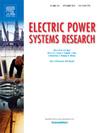物理引导的切比雪夫图卷积网络优化电力流
IF 3.3
3区 工程技术
Q2 ENGINEERING, ELECTRICAL & ELECTRONIC
引用次数: 0
摘要
随着风能和太阳能等可再生能源(RES)渗透率的不断提高,深度学习方法提供了解决方案,以高效的数据处理能力满足快速变化的电网运行的实时需求。然而,现有方法难以在充分提取数据特征和学习物理属性之间取得平衡,从而导致不理想的学习效果和有限的泛化。针对这一问题,本文提出了一种物理引导的切比雪夫图卷积网络(PG-CGCN),用于实时解决交流最优功率流(AC-OPF)问题。首先,我们利用最大信息系数,开发了基于拓扑嵌入的自适应邻接矩阵。该矩阵不仅承载了电网固有的拓扑结构,还反映了复杂的节点间关系,增强了模型的鲁棒性。接下来,基于空间域图卷积的切比雪夫卷积得以实现,并与卷积层和多层感知器相结合,进一步增强了模型的学习能力。这种结构能够有效提取局部和全局拓扑特征,同时考虑局部相关性和全局时间特征。此外,还构建了一个物理引导的损失函数,并根据拉格朗日对偶性对相应的乘数进行动态加权更新。这有助于将最优解映射到可行空间,同时减轻物理引导项带来的稳定性挑战。最后,来自三个不同的 IEEE 测试案例的实验结果表明,在不可见的 N-1 应急场景中,PG-CGCN 的预测性能优于最先进的方法,其预测结果与基本物理特性的吻合程度更高。本文章由计算机程序翻译,如有差异,请以英文原文为准。
Physics-guided Chebyshev graph convolution network for optimal power flow
As the penetration of renewable energy sources (RES), such as wind and solar, continues to increase, deep learning methods provide solutions to meet the real-time demand of rapidly changing grid operations with efficient data processing capabilities. However, existing approaches struggle to balance the sufficient extraction of data features and the learning of physical properties, resulting in undesired learning effects and limited generalization. To address this issue, this paper proposed a physics-guided Chebyshev graph convolution network (PG-CGCN) for real-time solving of the alternating current optimal power flow (AC![]() -OPF) problem. First, by utilizing the maximal information coefficient, we developed a self-adaptive adjacency matrix based on topological embedding. This matrix not only carries the inherent topological structure of the grid but also reflects complex inter-node relationships, enhancing the model's robustness. Next, Chebyshev convolution based on spatial domain graph convolution was implemented and combined with a convolutional layer and a multilayer perceptron to further strengthen the model's learning capability. This structure enables effective extraction of both local and global topological features simultaneously accounting for both local correlations and global temporal characteristics. Additionally, a physics-guided loss function was constructed, with dynamic weighted updates applied to corresponding multipliers based on Lagrangian duality. This encourages mapping the optimal solution to the feasible space while mitigating stability challenges introduced by the physics-guided term. Finally, experimental results from three different IEEE test cases demonstrate that, in unseen N-1 contingency scenarios, PG-CGCN achieves superior predictive performance compared to state-of-the-art methods, with its predictions showing a higher degree of alignment with the underlying physical properties.
-OPF) problem. First, by utilizing the maximal information coefficient, we developed a self-adaptive adjacency matrix based on topological embedding. This matrix not only carries the inherent topological structure of the grid but also reflects complex inter-node relationships, enhancing the model's robustness. Next, Chebyshev convolution based on spatial domain graph convolution was implemented and combined with a convolutional layer and a multilayer perceptron to further strengthen the model's learning capability. This structure enables effective extraction of both local and global topological features simultaneously accounting for both local correlations and global temporal characteristics. Additionally, a physics-guided loss function was constructed, with dynamic weighted updates applied to corresponding multipliers based on Lagrangian duality. This encourages mapping the optimal solution to the feasible space while mitigating stability challenges introduced by the physics-guided term. Finally, experimental results from three different IEEE test cases demonstrate that, in unseen N-1 contingency scenarios, PG-CGCN achieves superior predictive performance compared to state-of-the-art methods, with its predictions showing a higher degree of alignment with the underlying physical properties.
求助全文
通过发布文献求助,成功后即可免费获取论文全文。
去求助
来源期刊

Electric Power Systems Research
工程技术-工程:电子与电气
CiteScore
7.50
自引率
17.90%
发文量
963
审稿时长
3.8 months
期刊介绍:
Electric Power Systems Research is an international medium for the publication of original papers concerned with the generation, transmission, distribution and utilization of electrical energy. The journal aims at presenting important results of work in this field, whether in the form of applied research, development of new procedures or components, orginal application of existing knowledge or new designapproaches. The scope of Electric Power Systems Research is broad, encompassing all aspects of electric power systems. The following list of topics is not intended to be exhaustive, but rather to indicate topics that fall within the journal purview.
• Generation techniques ranging from advances in conventional electromechanical methods, through nuclear power generation, to renewable energy generation.
• Transmission, spanning the broad area from UHV (ac and dc) to network operation and protection, line routing and design.
• Substation work: equipment design, protection and control systems.
• Distribution techniques, equipment development, and smart grids.
• The utilization area from energy efficiency to distributed load levelling techniques.
• Systems studies including control techniques, planning, optimization methods, stability, security assessment and insulation coordination.
 求助内容:
求助内容: 应助结果提醒方式:
应助结果提醒方式:


